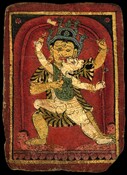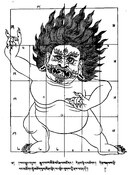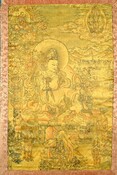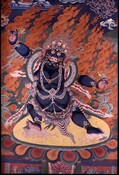Enlightened
Journey: Buddhist Practice as Daily Life. By Tulku Thondup, edited by
Harold Talbot. Shambhala: Boston & London, 2001.
![]()
 |
| Buddha Shakyamuni |
 |
| Ushnishavijaya |
 |
| Nyima Oser |
 |
| Marpa Chokyi Lodro |
 |
| Tsakli |
 |
| Mahakala Bernag Chen |
 |
| Ratnasambhava |
 |
| Chemchog Heruka |
In common Buddhism and especially
in tantric (or esoteric) Buddhism, the
essential training is to see and experience all the phenomena
as pure lands, Buddha bodies, teachings, and enlightened thoughts. If
we perfect such training, there will come a time when the whole universe
will arise as the qualities of the Buddha.
In such training, all forms, expressions, and thoughts are part of the training in realization. But here I am going to talk specifically about thangkas, Tibetan Buddhist pictorial scrolls, and their history, as an example if Buddhist teachings. Thangkas vividly illustrate the different ways of transforming the whole universe into teaching, inspiration and realization.
The
Historical Tradition of Thangkas: The Pictoral Scrolls of Tibet |
The history of Tibetan art has two stages. The first stage begins in the seventh century and the second stage in the eleventh century. I do not know what kind of art in the form of paintings and sculpture existed in Tibet before the seventh century.
In the seventh century, King Srongtsen Gampo (617-698) [18] married Princess Thritsun, the daughter of King Amshuvarman of Nepal and Princess Wen Ch’eng Kun Chu, daughter of Emperor T’ang T’ai Tsung of China. Both these princesses were devoted Buddhists, and they brought many priceless religious objects with them to Tibet. The most famous and one of the earliest images in Tibet, the Jowo, was brought to Tibet from China by princess Wen-Ch’eng. Many other precious Buddhist images and paintings by many skilled artists were brought to Tibet from both Nepal and China. In the seventh century, the Jokhang temple in Lhasa and the other 108 Thadul and Yangdul temples were built, and they were furnished with figures of religious importance. Most notably at the end of eighth century, King Thrisong Detsen (790-858) [19] built the famous Samye monastery, so rich in Buddhist iconography. Until the early ninth century successive kings of the Chogyal dynasty built many religious monuments.
Most of the artists of the earlier stage were non-Tibetans. But they selected among the Tibetans handsome men and beautiful women to be the models of the images and paintings of Buddhist male and female teachers and deities. Also, according to historical texts, many beautiful Buddhist images spontaneously arose from the earth and from rocks, and artists used those miraculous images as models for Buddhist pictorial arts. Slowly a new kind of architecture and pictorial art of Tibet emerged. In any case, the influence of Nepalese, Indian, Chinese, and Persian art was great. For example, in the construction of Samye monastery, it is said that each of the three stories of the main temple were built with inspiration from the arts and designs of three different countries: the ground floor is the style of Tibet, the second floor of China, and the top of India.
But during the reign of King Lang Darma in the early ninth century, with the destruction of Buddhism in central Tibet, the artistic life of that part of the country also suffered a total interruption for many decades.
Here it is important to note that not only the visual arts but even the written language was developed for the purposes of the establishment, practice, and propagation of Buddhism. Buddhism had become the basis and means of the life, culture, and literacy of the Tibetan people.
From the eleventh century, with the emergence of different artistic schools, the second stage of Tibetan art developed. There were many schools or traditions, but it seems that thee are six major ones that were important and popular at one period or another.
The first one is the Kadam (bKa’ gDam) school. In the eleventh century the kings of Guge in Western Tibet patronized the Buddhist art of the Tibetan tradition. For geographical reasons this early school was strongly influenced by the art of Kashmir, which itself was influenced by eastern Indian art developed under the rule of the Gupta kings (fourth-seventh centuries) and Pala kings (eighth-twelfth centuries) of India. This style of art is found in Spiti, Guge, Purang and Tsaparang.
The second school is the Palri (Bal Ris) or Nepalese school, which developed in the fourteenth and fifteenth centuries. Nepalese tradition was influenced by Pala art of eastern India. The arts of this school are found throughout Tibet and especially in Tashi Lhunpo monastery and also in some monasteries in eastern Tibet. According to Kongtrul Yonten Gyatso, the Nepalese school was the mainstream of Tibetan painting up to the fifteenth century.
The third school is the Menri (sMan Ris). In the beginning of the fifteenth century, Menlha Thondup, a famous artist from southern Tibet, founded the Menri tradition, which incorporated the Chinese (of Zi’u-than) style of the Mongol (Yuan) period. There is also a second Menri tradition known as New Menri. In the seventeenth century, Choying Gyatso, a follower of the Menri school, started his own school. He painted the wall paintings of the Chokhang Shar temple and the stupa containing the body of the first Panchen Lama (1570–1662) in Tashi Lhunpo.
The fourth school is the Khyenri (mKhyen Ris) school. In the sixteenth century Khyentse Chenmo of Gongkar Gangto started a new tradition of art. But later this school merged with the new Menri tradition.
The fifth school is Karma Gardri (sGar Bris). In the sixteenth century Namkha Trashi founded his own school incorporating the Menri, Indian, and Chinese (Zi’u-than) traditions. This tradition was propagated by the artists Choje Trashi and Karma Trashi.
The sixth school is the Dopal (‘Dod dpal) school. In the seventeenth century, during the reign of the fifth Dalai Lama (1617–1682), the artists Epa Kugpa (or Hordar) and Tulku Pagtro established their own traditions. A college of art named Dopal (or ‘Dod ‘Jo dPal ‘Khyil) situated at the foot of the Potala palace in Lhasa follows this tradition. So the tradition of these two artists and of this college became known as the Dopal school.
Varieties of Thangkas |
In Tibet there are rich traditions of various crafts, such as weaving, sculpture, carving, metal work, carpentry, and so forth. But here I would like to explain the significances of thangkas or Tibetan pictorial scrolls as an illustration of these crafts. Thangkas are an upright rectangular form mounted and framed with silk or brocade. They are sacred objects hung on the walls of temples and in shrines as objects of homage and as the support of spiritual practice. But nowadays we also find them as decorations in houses and hotels.
There are two kinds of thangkas; one is called gothang, silken pictorial scrolls, and the other, trithang, the painted scrolls. In terms of fabricating them there are four kinds of silken scrolls: (1) Tsemtrubma is a hand-embroidered pictorial art form using silk threads of different colors. (2) Thagtrubma have figures woven by hand with different colored silk threads. (3) Tretrubma have stitched figures. Many small pieces of silk are cut into shapes and are stitched together for the different designs. (4) Lhenthabma is a glued silk scroll. The different colored silks are cut into designs and glued into figures. The variety of size of the silk scroll can be from 30 by 20 centimeters to 55 by 47 meters.
There are four main categories of painted scrolls, distinguished mainly by the color of the background of the paintings. (1) Tsonthang is a painting having different colors for the background of the painted scrolls. (2) Serthang is a painting having gold for the entire background color. The figures and designs are drawn with ink or vermilion on the gold background, and in some cases the figures are painted on the gold. (3) Tsalthang is a painting having vermilion for the background, on which the design is drawn with gold or ink. Sometimes, as with the serthang, figures are painted. (4) Nagthang is a painting having black for the background color, on which the figures are drawn in gold or sometimes with vermilion, and occasionally painted with various colors. The dimensions of painted scrolls can vary from 30 by 20 cm to 3 by 2 m.
There are three other types of painting, which differ from the others in respect to design, size, and use. The first is kyilkhor in Tibetan or mandala in Sanskrit. It literally means the “assemblage.” It is mainly the floor plan of the residence of tantric deities, Buddhas, and their retinues. It is an assemblage because it is a place where the deity and his retinue are in assembly. Each deity has a different form of mandala, in which the architectural details and colors symbolize different esoteric wisdoms. Mandalas are a variety of shapes: circle, square, triangle, and semicircle. They are mostly painted on square canvases and are used as objects or supports for meditation, rituals, and empowerments, for which purposes they are spread on the altar. They may also be put in mounts or frames and hung on the wall.
The second type is tsakli. Tsakli are miniature paintings of an upright rectangular shape. Their subjects are mainly figures of various deities and also sacred attributes and objects. They are primarily for use in empowerment ceremonies for the transmission of Buddhist esoteric powers. They are kept on the altar table or on the mandalas. But they can also be put in frames and hung on the wall.
The third type is kyanglha, wall paintings or frescos. They can be various colors usually painted directly on walls, and sometimes on canvas affixed to the wall. They are mostly square in shape, a number of these squares covering most of the wall space of temples and shrine rooms.
In all Tibetan art forms there are strict and creatively ordered patterns to which the icons must conform. Each of the different figures in sacred art has a clearly defined set of dimensions, forms, colors, positions, gestures, symbols, and significances.
The
Religious Significances of Thangkas |
For over twelve centuries Buddhist teachings deeply influenced and guided all aspects of Tibetan life and culture. Eventually the discipline of Buddhism became preeminent in all levels of Tibetan life. Thus, any presentation of the history, culture, literature, life, or fine arts of Tibet has to involve predominantly the teachings and practices of Buddhism. This is very true in the case of Tibetan art, painting, and sculpture, the function of which is the expression and representation of religious themes. In Tibetan art one finds very little that has no religious meaning. In Tibet each well-established home has a separate shrine room with rich religious objects, which are honored with daily offerings. Even in the simplest home or in huts a shrine table will be found displaying some religious objects. These religious symbols are a source of happiness, peace, and energy for those who possess Dharma eyes. Every day the householder say prayers before the sacred objects on the shrine and make offerings of flowers, incense, food, drink, and particularly bowls filled with clean water and butter lamps. This is a means for people to develop generous, peaceful, and clear minds so that they can earn merit, which they believe to be the source of a happy future.
To understand the meaning of Tibetan pictorial art it is important to have some idea of the meaning of Buddhist visualization practices. Among the iconographic figures, there are representations of different male and female Buddhas, sages, and gods. In Buddhism, the scholars classify the bodies of the Buddhas into three categories – the Dharmakaya or “absolute body,” Sambhogakaya or “enjoyment body,” and the Nirmanakaya or “manifested body.”
Dharmakaya is the absolute state, which is Buddhahood. It is free from all conceptualizations and has no form or characteristics. But in pictorial art, sometimes it is represented by an image of a naked Buddha, blue in color, symbolizing the fully enlightened state, free from all elaborations, like the sky or empty space.
Sambhogakaya is the most subtle, pure, and supreme form of body of the Buddha. The Sambhogakaya can be seen only by those who have obtained at least the first stage of the ten stages of the Buddhist goal of attainment. It has numerous forms, details, and significance, but we can classify them into two categories. The first includes the peaceful forms with thirty-two major and eighty minor excellent signs. They are attired in thirteen Sambhogakaya costumes – five silken articles of vestment and eight ornaments of precious materials, symbolizing the completion or perfection of all the virtues and attainments. But some Sambhogakaya figures are clothed in monastic robes. Those of the second category are the wrathful forms. They have nine wrathful expressions and are attired in eight cemetery costumes, symbolizing the destruction of all the mental demonic forces and the transformation of defiled emotions, such as anger, into the state of wisdom.
Nirmanakaya is the manifested body of the Buddha in carious kinds of ordinary forms for the sake of beings. They are in the forms and costumes of Buddhas, Bodhisattvas, ascetics, and monks. The forms of the Buddhas who have appeared in this earthly world, such as Shakyamuni Buddha, are called the supreme Nirmanakaya, and they are like the peaceful Sambhogakaya forms, distinguished by the one hundred twelve excellent signs; but they are clothed in monastic robes and not ornamented vestments. Most of the bodhisattvas, such as Manjushri, are in princely costumes fully or partially, like the vestments of the peaceful Sambhogakaya form. The ascetics, who follow the esoteric practices, are in the costumes of yogis – simple and carefree. The representations of the monks, who have renounced their household life, are in monastic robes with shaven heads or monastic hats.
There are also Bodhisattvas, ascetics, and monks who are not Nirmanakayas but ordinary beings, and the pictorial figures for them are the same as or similar to those of the Nirmanakayas. Another category of figures are the gods and demons. Those powerful beings or spirits who are supporters of virtues, the positive forces, are called gods or Dharma protectors, and those who are evil or negative forces are called demons. In Tibetan the word for god is Lha, or in Sanskrit, deva.
According to Buddhism, gods dwell mostly in heaven and enjoy happiness, being fortunate and powerful for the time being. But they are worldly beings and not enlightened ones. They have not attained nirvana, freedom from defiled emotions and their effects, so they are subject to wandering around the world when their past karmic merit is exhausted.
Each of the different figures and colors of those representations in the thangkas has a special meaning and significance for visual meditation. I will give the significance of two figures as an example of the symbolism of Buddhist art.
The first is the image of Manjushri, the Bodhisattva of Wisdom. His body of orange color shines like a rising sun, symbolizing clearness from the clouds of the two obscurations – the intellectual obscuration and emotion obscuration. His five silken vestments and eight jewel ornaments symbolize that he is adorned with all the virtues of Sambhogakaya. He is sitting in cross – legged posture, symbolizing his abiding in the absolute state of equanimity without wavering. His clear eyes are wide open, symbolizing that he has ceaseless love for all impartial wisdom concerning all as they are. He is smiling, symbolizing that he is free from suffering and filled with pace and joy. He is youthful, symbolizing that he is not subject to old age and sickness, nor to death and birth. In his right hand, he brandishes a blue sword over his head, symbolizing his speech, which cuts the ignorance of beings at its roots. In his left hand, he holds a volume of Prajnaparamita (transcendental wisdom), symbolizing his mind, which possesses the two wisdoms – the wisdom of knowing all as they are and as they appear. His body is endowed with thirty-two excellent signs and eighty excellent marks, symbolizing his perfection of the virtues of the Buddha.
The second example is Chechog or Mahottaraheruka, a wrathful deity, as described in Palchen Dupa of the Longchen Nyingthig tradition. His three heads symbolize the three bodies of the Buddha. His six arms symbolize the six perfections. His four legs symbolize the four boundless attitudes.
His central head is fearsome and in the vajra anger form, symbolizing the destruction of ignorance by transforming it into the sphere of Dharmakaya. His right head is white, thundering with the roar of “ha-ha,” symbolizing the destruction of attachment by transforming it into the sphere of the enjoyment body. His left head is red with bared teeth in am-tsig dam-pa gesture, symbolizing destruction of anger by transforming it into the sphere of the manifested body of the Buddha. The five–pronged vajra in his first right hand symbolizes the elimination of the five defilements by transforming them into the five wisdoms. The trident in his second hand symbolizes the transformation of the three poisons into the three bodies of the Buddha. The flame in his third right hand symbolizes the burning of grasping at phenomena as true. The skull in his first hand symbolizes the transformation of the three poisons into the nectar of wisdom. The plow in the second left hand symbolizes subduing greed by generosity. The scorpion in his third left hand symbolizes the elimination of all the evil forces. The eagle over his head symbolizes his victory over all negative forces. His eightfold cemetery costumes symbolizes that he is the destroyer of demonic ego.
Here, it is important to say a few words about the significance of wrathful Buddha images. For is, while it is easy to understand and also inspiring to see peaceful and contemplative images, the wrathful images and images in sexual union are difficult to comprehend as a part of the enlightened path and result. There is not any concept of such images in common Buddhism of the sutra tradition; it is only in the esoteric (tantric) tradition. According to esoteric Buddhism, which only for highly accomplished mediators or adepts, there is no distinction of peace or wrath, as all are equal in being illusory and are one in the ultimate state of realization. In the true nature, wrathful form is not excluded or negative, as all phenomenal existents are included as one in peace, joy, and openness.
There are two main purpose in using wrathful images for practice: generating positive energies and taming negative forces. The power or energy of wrathful forms is a great skillful means. It creates and refines the potency of the accomplishment of esoteric experiences and the awakening of the wisdoms – the wisdoms of the union of bliss and emptiness or openness, the union of appearance and emptiness, and the union of clarity and emptiness.
The wrathful forms are powerful tools in taming strong negative forces. It is not different from a Buddha manifesting in the form of a human being for us and as a monkey for the monkeys. They are not creations or reactions of emotional affliction or selfish craving. They are reflections of peaceful and enlightened mind in the mold of appropriate form.
The most important point is that though they appear in wrathful form and the sound associated with them is of a fearful expression, they are, or their minds are, peaceful, powerful, and compassionate. Every wrathful deity embodies the following nine main qualities: haughty, heroic, and fearful with respect to body, and compassionate, powerful, and peaceful with respect to mind.
In Buddhism people do not worship images as the representation of a creator of the world, or as a provider or source of happiness. Instead, they use external objects, such a religious artifacts, as a support or source of inspiration for their spiritual practice. According to the Buddhist conception, the main factor in life is the mind. If the mind has right intention or the right perception of the objects that are being used as a support for religious practice, such as seeing them as Buddhas, it will help develop faith and other mental virtues. In this way the devotee will achieve merit and gain spiritual strength. The using of objects sacred art as support for religious practice does not derive its effectiveness from the power of the objects themselves, but from the attitude of the mind of the practitioner. Of course, using appropriate objects such as religious art forms will have a greater influence on the mind than an ordinary object, such as a table. For example, if one’s surroundings are filled with illustrations of passionate figures, by seeing them, hatred or lust will arise in the mind. In the same way, if one’s dwelling is filled with religious illustrations, if one has some spiritual experience, it will be a reminder of or will refresh that spiritual experience.
Almost all Tibetan art takes its origin from the Buddhist teachings. It is the support of Dharma practice and the tool of Dharma propagation. It represents and preserves the essence of the Dharma.
NOTES
18.
The dates for King Srongtsen are based on DPM 18b/5 and DPM 69a/3.
19.The dates for Thrisong Detsen are based on DPM 79b/4
and DPM 155a/3.
_________________
(A
talk given at the opening of the exhibition of Himalayan Sacred Art at
the Danco Gallery, Northampton, Mass., on October 29, 1981. This chapter
is based on KHR 998/17-1006/4; SG vol.I, 586/2I-580/14, &vol. 2, 247/I-303/II;
and TRA 36.)
 |
| King Songtsen Gampo |
 |
| Achala |
 |
| Shamarpa |
 |
| Karmapa
IX, Wangchuk Dorje |
 |
| Avalokiteshvara - Chaturbhuja |
 |
| Tagla Membar |
 |
| Samantabhadra |
 |
| Manjushri - Arapachana |
Essay ©
Tulku Thondup
Copyright © Shelley and Donald Rubin Foundation